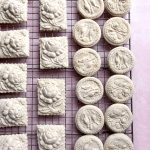Springerle (German Embossed Cookies)
- Yield: 2–6 dozen, depending on the size of your cookie mould 1x
Ingredients
Scale
- ¼ tsp LorAnn Oils Baker’s Ammonia
- 1 Tbsp whole milk
- 3 large eggs, room temperature
- 3 cups (341g) confectioners’ sugar, sifted
- ¼ cup (57g) unsalted butter, softened
- ¼ tsp salt
- ¼ to 3/8 tsp anise oil [1]
- zest of 1 orange or lemon, optional
- 3 ¾ cups (450g) cake flour, sifted
Instructions
- In a small bowl, mix together baker’s ammonia and milk. Set aside for 20 minutes.
- In the bowl of a stand mixer fitted with whisk attachment, whip eggs on medium-high speed until thick and pale yellow (10–20 minutes).
- With mixer on medium-low, add confectioners’ sugar a few tablespoons at a time, scraping down the bowl as necessary.
- Beat in butter, then mix in milk mixture, salt, anise oil, and (optional) citrus zest.
- Switch to paddle attachment, then with mixer on medium-low, add flour a few tablespoons at a time, scraping down the bowl as necessary.
- Once all flour has been incorporated, turn dough out onto a floured surface. If necessary, knead in additional flour so that you can make a good imprint in the dough without your mould sticking.
NOTE: Unsure if your dough has enough flour? Test it by flouring and pressing a mould into it! - It’s not completely necessary, but if desired, at this point you can refrigerate your dough in a sealed container or tightly sealed bag for up to 2 days. This gives the liquids time to absorb into the flour.
- When you’re ready to form your cookies, line baking sheets with parchment paper. Flour your work surface and your rolling pin. Roll dough until it’s roughly ½-inch thick.
NOTE: Depending on the depth of your springerle mould’s carving, you may need to roll your dough thicker to thinner. - Flour your mould before each pressing. Firmly press mould straight down into the dough, then lift mould straight up. Cut out cookie using a pastry wheel or cookie cutter (or a round biscuit cutter, which is what we did!) then transfer to prepared baking sheet. Flour mould again and repeat, making sure to group same-sized cookies on the same baking sheets.
- Let springerle dry—uncovered—for 12 to 24 hours to set the embossment.
NOTE: Especially large springerle or hot, humid weather may cause your cookies to require more drying time. - When you’re ready to bake, heat oven to 300°F.
- Bake springerle for 10–15 minutes or until barely golden on bottom.
- Carefully transfer cookies to a wire rack. Allow to cool completely.
Notes
- While anise is the traditional flavour of springerle, we know that its liquorice taste isn’t everyone’s cup of tea. Here are some other flavour ideas:
- Vanilla: 1 ½–2 tsp vanilla extract
- Almond: ¼ tsp almond extract
- Citrus: 1 ½–2 tsp lemon/orange oil OR ½ tsp oil + zest of 2 lemons/oranges
- Holiday: ¼ tsp cinnamon or peppermint oil
- Cappuccino: 1 Tbsp coffee extract + 1 tsp ground cinnamon
- Chocolate: Replace ½ cup (60g) cake flour with ½ cup (42g) cocoa powder. Add 1 tsp vanilla or chocolate extract.
- Mocha: Replace ½ cup (60g) cake flour with ½ cup (42g) cocoa powder. Add 1 tsp coffee extract.
Source: House on the Hill

